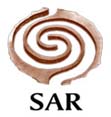 SAR News:
SAR News:SANTA FE ― The rich cultural history and significance of rock art and petroglyphs in the Rio Grande Valley, and an exploration of those artifacts, make up two must-attend events sponsored by the School for Advanced Research (SAR) in April.
“Rock Art and Pueblo Shields: Symbolism and Change,” a public talk by Polly Schaafsma is 3:30-5 p.m., Wednesday, April 26 at SAR. Then 9 a.m. to 3 p.m., Friday, April 28, see examples of petroglyphs as you explore “Mesa Prieta: 100,000 images, 7,500 years of Rock Art,” a field trip to Mesa Prieta, north of Santa Fe.
Presented in partnership with the Mesa Prieta Petroglyph Project, Schaafsma’s talk April 26 focuses on Pueblo shields, spectacular components of pre-Hispanic rock art in the northern Rio Grande valley, including at Mesa Prieta, where they are found in large numbers. She will discuss and show examples of rock art (painted symbols) and petroglyphs (images carved into rock), exploring their symbolism and functions in the landscape.
Brief comparisons will be made with historic shields, as well as the significance of the observed iconography and how it has changed over the centuries. More info here: http://www.puebloshields. sarweb.org/
“The shield depicted in the environment would have the same protective powers as a battle shield. Shields are power symbols, and their designs are a means of empowering both the shield bearer and the shield itself,” says Schaafsma, an archaeologist and research associate at the Laboratory of Anthropology, Museum of New Mexico, best known for her publications on Native American rock art. “Petroglyphs of shields on Mesa Prieta are numerous.”
The Mesa Prieta Petroglyph Project has some of the most spectacular examples of rock art in northern New Mexico. On April 28, field trip leader Richard I. Ford, Arthur F. Thurman Professor Emeritus of Anthropology and Botany in the Department of Anthropology at the University of Michigan, will talk about the mesa, permaculture, and early agricultural practices of the area.
Complementing Ford’s talk, and following the morning tour at Mesa Prieta, participants will have a traditional meal prepared by Brenda Fender from San Ildefonso Pueblo. Erik Fender will provide an overview of his artwork, including pottery and painting, and discuss how rock art from Mesa Prieta and other sites, influence his creativity. This is a unique opportunity to experience Pueblo life, including both cooking and art, which remain an integral part of a dynamic culture.
More on the field trip, here: http://www.mesaprietatrip. sarweb.org/
In 2007, Katherine Wells donated 156 acres on Mesa Prieta to the Archaeological Conservancy. She had the vision for a preservation and educational effort for Mesa Prieta and the determination to develop a program dedicated to its protection. She is still an active volunteer with the Mesa Prieta Petroglyph Project.
“Until the project started, only a small handful of archaeologists and rock art buffs knew about the extraordinary richness of the site,” Wells said. “No one really understood the cultural importance either. It’s been protected by its anonymity, but it is important for visitors and New Mexicans to understand that this is part of the cultural history of the state.”
The April 26 Pueblo shields talk is $5 and open to the general public; SAR members and Mesa Prieta field trip participants are free. The April 28 Mesa Prieta field trip is limited to twenty participants, who must be members of SAR. Nonmembers can join at http://www.sarweb.org/?become_ a_member. The cost is $275 per person and includes a $50 donation to SAR, lunch, transportation, gratuities, and water on the bus. More on the field trip and talk, here: http://www.mesaprietatrip. sarweb.org/
About Mesa Prieta Petroglyph Project
The Mesa Prieta Petroglyph Project, a tax-exempt 501 (c)(3) nonprofit organization founded in 1999, seeks to preserve petroglyphs on Mesa Prieta through education of the local community and others, and recording what may be well over 100,000 rock images on the mesa. For more, visit www.mesaprietapetroglyphs.org
About the School for Advanced Research (SAR)
The School for Advanced Research has supported innovative social science research and Native American artistic creativity for more than a century. Since we began offering fellowships in 1972, we have funded the work of more than 350 SAR scholars and artists, among whose ranks are six MacArthur Fellows and eighteen Guggenheim Fellows. Please join us in Santa Fe for insightful lectures or a tour of the School’s historic campus. You can also follow the work of our resident scholars and Native American artists on our website, www.sarweb.org, Facebook, and Twitter.

